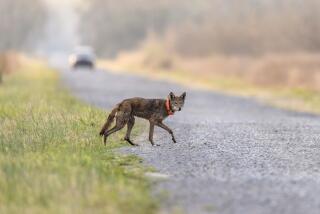Fearful Residents Oppose Roanoke Refuge Plan
- Share via
SCOTLAND NECK, N.C. — Hunters and biologists speak in reverent tones of the Roanoke River bottomlands, a paradise for game and a modern-day miracle of undisturbed hardwoods.
Indians called the Roanoke “the river of death” for its treacherous floods. The U.S. Fish and Wildlife Service sees it as an artery of life and hope for the threatened black duck and other species.
The Wildlife Service has proposed spending about $15 million to buy 30,000 acres along the Roanoke to serve as a refuge but is meeting stiff opposition from residents who fear a federal land grab. Others dispute the Roanoke’s significance as a habitat for the black ducks and charge that the government will be paying a grossly inflated price for land valued at $60 an acre or less.
Opposition also has come from county officials who fear losing tax revenues and from hunting clubs that stand to lose their private shooting preserves.
One County Against
Of the three counties involved, Bertie, Martin and Halifax, Martin has gone on record against the refuge, Halifax is considering a resolution favoring it and Bertie has not taken a stand.
“They could end up with my farm if they want it,” said Johnny Shields, an avid hunter and young farmer who works nearly 3,000 acres just outside Scotland Neck.
“They carry a big stick and condemnation has happened before,” Shields said.
James W. Pulliam Jr., the Wildlife Service’s southeast regional director in Atlanta, has tried to ease fears of land condemnations by stressing that the federal government is interested in buying only from “willing sellers.”
He said he did not consider the land condemnation fears “legitimate concerns,” but conceded that he did not know how to resolve them.
“The people are aware the federal government does have the right of eminent domain . . . and things being what they are, people just don’t trust federal bureaucrats,” he said.
“You can tell them you do not intend to condemn land, but I think they just don’t believe it.”
Owned by Timber Companies
About 25,000 of the 30,000 acres the federal government wants to buy are owned by five timber companies. The rest is held by about 30 individuals and businesses.
Since the land would be purchased with monies raised through sale of the federal duck stamp--a stamp waterfowl hunters must buy in addition to their regular hunting license--the project has to have the approval of Gov. James G. Martin. The governor is awaiting a recommendation on the issue from the North Carolina Wildlife Resources Commission.
The North Carolina Nature Conservancy, which has 12,000 members, is leading the fight for the refuge.
Catherine G. Skinner, executive director of the conservancy, calls the Roanoke’s ecology system a “hunter’s and naturalist’s paradise. It is the most extensive stand of hardwoods found in the state and mid-Atlantic region.”
The Roanoke begins in central Virginia and snakes southeastward into North Carolina, making several large loops, called “necks,” before flowing into Albemarle Sound a few miles past the town of Plymouth.
Trees Shelter Wildlife
Centuries of flooding have left rich bottomland where bald cypress, tupelo gum, willow oak, sweetgum, hickory and other hardwoods provide a variety of food and cover for an almost limitless game population.
Deer, turkey, ducks and beaver flourish, as do otter, bobcat and raccoon. There are at least three egret and heron rookeries in the proposed refuge area, which is also home to North Carolina’s threatened Cerulean warbler, Mississippi kite, bald eagle, osprey, Cooper’s hawk and other unusual birds.
The United States and Canada, alarmed by the steady decline of ducks and other waterfowl, have embarked upon a North American waterfowl management plan, with the goal of bringing the continent’s waterfowl populations back to the levels of the 1970s.
Jim Gillett, chief of the Division of National Wildlife Refuges, said acquisition of the Roanoke lands would “make an important contribution” to black duck habitat.
“It’s amazing that there’s such a tract of undisturbed, or reasonably undisturbed, hardwood bottomland,” he said.
‘Critical Species’
Gillett said the black duck was targeted for special attention because it is the “most critical species,” since it is found all along the East Coast north of South Carolina.
He said the black duck population over many years has “shown a consistent downward trend and nothing up to this point in time has seemed to have thwarted it.”
Black ducks dropped in number in the Atlantic Flyway from 600,000 in 1955 to about 200,000 in 1987. Of that 200,000, Pulliam said, “many use the Roanoke River Basin during migration and for wintering grounds.”
But Connell E. Purvis, spokesman for a group called Friends of the Roanoke River Bottom, challenged Pulliam’s claim.
“Our people who are serious duck hunters have seen occasional black ducks, but there’s nobody that has tramped the Roanoke River that has ever seen a significant number of black ducks,” said Purvis, who added that his organization has “500 or so” members.
Purvis’ group contends that there are better alternatives to creating habitat for black ducks, especially by developing refuges in coastal counties.
Some See Wastage
It further argues that at a time when the national debt is of concern, the federal government is proposing to pay $500 an acre for land valued on the tax books at $35 to $60 an acre.
Thousands of acres of prime bottomland and swamp have been destroyed in interior portions of the Southeast by the construction of reservoirs, lakes, ponds and agricultural development, and the Wildlife Service believes that it is only a matter of time before the remaining areas are developed, unless the land is set aside.
More to Read
Sign up for Essential California
The most important California stories and recommendations in your inbox every morning.
You may occasionally receive promotional content from the Los Angeles Times.










